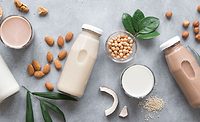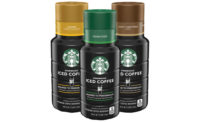Higher Ground
By JENNIFER ZEGLER
Consumer expectations have elevated coffee
Consumers who were
previously addicted to coffee mainly for its
caffeine fix are now expecting more from their java. These days coffee is
more than just a pick-me-up. Some consumers seek single-origin beans, while
others are treating themselves to indulgence, and still more are searching
for coffees that promise an added function.
“It’s changing — not only at retail
— but consumers are coming to expect a higher coffee experience
wherever they go,” says David Morris, senior analyst for beverages at
Mintel International, Chicago.
From indulgent to functional, foodservice has been one
area that continues to drive innovation in the coffee category.
“Quick-service restaurants and coffeehouses are
finding that new coffees are a way to be able to increase margins in the
morning,” Morris says.
| Top 5 ground coffees (Individual brands) | ||||
| BRAND | DOLLAR SALES (IN MILLIONS) |
SALES % CHANGE VS. YEAR AGO |
MARKET Share |
% CHANGE VS. year AGO |
| FOLGERS | $449.0 | 1.0% | 21.3 | -0.9% |
| MAXWELL HOUSE | $343.4 | -2.7% | 16.3 | -1.3% |
| STARBUCKS | $219.7 | 12.4% | 10.4 | 0.7% |
| FOLGERS COFFEE HOUSE | $188.4 | 42.6% | 8.9 | 2.3% |
| PRIVATE LABEL | $170.4 | 3.8% | 8.1 | -0.1% |
| TOTAL CATEGORY | $2,111.0 | 5.1% | 100.0 | – |
| Source: Information Resources Inc., Chicago, sales from total U.S. food, drug and mass merchandise outlets (excluding Wal-Mart) for the 52 weeks ending Oct. 7, 2007. | ||||
Quick-serve restaurant chain McDonald’s has been improving its coffee offerings since the 2006 launch of premium coffee and this spring’s iced coffee program. The Oak Brook, Ill.-based chain attracted attention once again when it announced this fall’s test of McCafe Specialty Coffees in the St. Louis area. Through January, Missouri consumers can sample specialty drinks free on Mondays. The special brews include Vanilla Lattes, Café Mocha and Caramel Cappuccinos, which McDonald’s hopes to roll out nationally in 2008.
This fall, convenience store chain 7-Eleven, Dallas,
went for functional appeal with its Fusion Defense coffee. The functional
brew features echinacea, ginseng and astragalus to help defend consumers
during the cold and flu season, the company says. Fusion Defense joins
Fusion Energy and more varieties as the chain expands the functional coffee
line.
As some chains expand their restaurant offerings,
Dunkin’ Donuts, Canton, Mass., expanded its coffee brand into retail.
The coffee and baked goods chain partnered with Cincinnati’s Procter
& Gamble for the September introduction of Dunkin’ Donuts coffees
at grocery stores. The coffees are sold in Original Blend, French Vanilla,
Dunkin’ Decaf, Hazelnut and Cinnamon Spice ground varieties as well
as a whole bean version of Original Blend.
Coca-Cola, Atlanta, partnered with Minneapolis-based
coffeehouse chain Caribou Coffee for the launch of branded RTD coffees,
which debuted this summer. Mintel’s Morris says it’s part of a
larger retail trend regarding cross-branding of recognized coffee brands at
retail.
For Starbucks fans, availability of its branded
products has become nearly as ubiquitous as its coffeehouse locations.
Seattle-based Starbucks’ RTD coffees accounted for nearly 90 percent
of retail sales in food, drug and mass merchandise outlets in 2006,
according to data from Mintel. This holiday season a special Dark Chocolate
Peppermint Mocha Frappuccino hit shelves and the company will add Dark
Chocolate Mocha in the spring.
In October, the
company made available Starbucks Limited Reserve line of limited-edition
coffees from specific coffee-growing regions. The initial blends come from
Colombia, central Africa and Papua New Guinea. Limited Reserve is part of a
larger trend in coffee toward single-origin blends.
Coffee extract supplier X-Café, based in
Princeton, Mass., provides coffee extracts to private label beverage
manufacturers and foodservice accounts and has long recognized the
importance of single-origin coffee.
“I think the next big thing in coffee extracts
will be single-origin taste profiles,” says Cathy Kalenian,
co-founder and chief financial officer of X-Café. “It was in
our initial foundation as a company and specialty coffee manufacturers have
realized that single origins have unique flavors.”
Solid grounds
The grocery channel is where 80 percent of coffee
purchases are made, according to Jerry Densk, director of marketing for
mainstream coffee at Kraft, Northfield, Ill. Yet, the major brands,
including Kraft’s Maxwell House and Procter & Gamble’s
Folgers have faced a challenging period. The traditional brands are caught
between a younger demographic that wants more premium varieties and a loyal
older demographic, which is not as interested in premium coffee, different
flavors or higher price points, Morris says.
| Top 5 ready-to-drink cappuccino/iced coffees (Individual brands) |
||||
| BRAND | DOLLAR SALES (IN MILLIONS) |
% CHANGE VS. YEAR AGO |
MARKET Share |
% CHANGE VS. year AGO |
| FRAPPUCCINO | $184.2 | 2.5% | 70.5 | -6.8% |
| DOUBLESHOT | $26.3 | -8.5% | 10.1 | -2.3% |
| STARBUCKS ICED COFFEE | $13.7 | 129.3% | 5.2 | 2.7% |
| BOLTHOUSE CAPPUCCINO | $11.8 | 99.1% | 4.5 | 2.0% |
| GODIVA BELGIAN BLENDS | $10.2 | 1,710.0% | 3.9 | 3.7% |
| TOTAL CATEGORY | $261.3 | 12.4% | 100.0 | – |
| Source: Information Resources Inc., Chicago, sales from total U.S. food, drug and mass merchandise outlets (excluding Wal-Mart) for the 52 weeks ending Oct. 7, 2007. | ||||
To increase appeal, Folgers released Simply Smooth stomach-friendly coffee and Gourmet Selections flavored premium line in 2006. Last month, Maxwell House re-launched its coffee, now made with 100 percent Arabica beans.
“When we talked to consumers, they wanted a
fuller cup of coffee with less bitter taste,” Densk says. “We
think it’s the best cup of coffee we’ve ever made and
we’re delivering on what they have asked.”
Additionally, the coffee and RTD coffee category
continues to innovate to attract more consumers. One new trend in the
category is hybrid products, such as Java Monster from Hansen Natural
Corp., Corona, Calif., which is a crossover between RTD coffee and an
energy drink.
“What’s fascinating are the
hybrid-oriented products, which is one of the more ominous trends [for
traditional coffee companies],” Morris says. “The trend offers
potential for energy drinks, which tend to skew younger and more toward
Hispanics and African Americans, to cut into the ability to sell an energy
boost that used to be available via coffee. These products also can take
the consumer out of the coffee realm and into energy drinks over
time.”
Introduced in June, Java Monster is available in three
coffee flavors — Big Black, Loca Moca and Mean Bean. The 16-ounce
dairy-based drinks blend coffee with Monster’s energy ingredient
blend. (To find out more about Java Monster see page 26)
Find out more online
For more on Starbucks’ recent innovations, visit www.bevindustry.com to read the November cover story.
For more on Starbucks’ recent innovations, visit www.bevindustry.com to read the November cover story.

